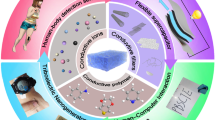Abstract
Non-isocyanate polyurethane (NIPU) is one of the hot spots in the scientific research of polyurethane. In this work, mechanically regulable NIPU were prepared by ring-opening polymerization of cyclic carbonates via diamines. Cyclocarbonates with different functionalities were firstly synthesized by thiol-ene click reaction, which was characterized through nuclear magnetic resonance spectroscopy and Fourier transform infrared spectroscopy. The controllable mechanical performance of NIPU films was obtained by the structure of the diamines and the functionality of the thiol groups. The results of swelling and differential scanning calorimetry experiments suggested that the control of functionality and reactivity endowed the material with an adjustable crosslinking density. The Young’s modulus of the material could be regulated from 51.3 to 765.1 MPa. Furthermore, the studied films also showed good thermal stability. The present study provides some guidance for the preparation of non-isocyanate polyurethane coatings for different application scenarios.











Similar content being viewed by others
References
Xu JianHua, Chen JiaoYang, Zhang YaNa, Liu T, Fu JiaJun (2021) A fast room-temperature self-healing glassy polyurethane. Angew Chem-Int Ed 60(14):7947–7955
Zhang ZP, Rong MZ, Zhang MQ (2018) Mechanically robust, self-healable, and highly stretchable “living” crosslinked polyurethane based on a reversible CC bond. Adv Funct Mater 28(11):1706050
Wang X-Z, Lu M-S, Zeng J-B, Weng Y, Li Y-D (2021) Malleable and thermally recyclable polyurethane foam. Green Chem 23(1):307–313
Xie F, Zhang T, Bryant P, Kurusingal V, Colwell JM, Laycock B (2019) Degradation and stabilization of polyurethane elastomers. Prog Polym Sci 90:211–268
Phaneuf MD, Dempsey DJ, Bide MJ, Quist WC, LoGerfo FW (2001) Coating of Dacron vascular grafts with an ionic polyurethane: a novel sealant with protein binding properties. Biomaterials 22(5):463–469
Gomez-Lopez A, Panchireddy S, Grignard B, Calvo I, Jerome C, Detrembleur C, Sardon H (2021) Poly(hydroxyurethane) adhesives and coatings: state-of-the-art and future directions. Acs Sustain Chem Eng 9(29):9541–9562
Huang S, Liu G, Hu H, Wang J, Zhang K, Buddingh J (2018) Water-based anti-smudge NP-GLIDE polyurethane coatings. Chem Eng J 351:210–220
Ramezanzadeh B, Ghasemi E, Mahdavian M, Changizi E, Mohamadzadeh MMH (2015) Covalently-grafted graphene oxide nanosheets to improve barrier and corrosion protection properties of polyurethane coatings. Carbon 93:555–573
Wang C, Yi Z, Sheng Y, Tian Li, Qin L, Ngai To, Lin W (2019) Development of a novel biodegradable and anti-bacterial polyurethane coating for biomedical magnesium rods. Mater Sci Eng C-Mater Biol Appl 99:344–356
Delebecq E, Pascault J-P, Boutevin B, Ganachaud F (2013) On the versatility of urethane/urea bonds: reversibility, blocked isocyanate, and non-isocyanate polyurethane. Chem Rev 113(1):80–118
Ghasemlou M, Daver F, Ivanova EP, Adhikari B (2020) Synthesis of green hybrid materials using starch and non-isocyanate polyurethanes. Carbohydr Polym 229:115535
Li X, Yu Z, Zhang L (2021) Synthesis of a green reactive flame-retardant polyether polyol and its application. J Appl Polym Sci 138(14):50154
Konieczny J, Loos K (2019) Green polyurethanes from renewable isocyanates and biobased white dextrins. Polymers 11(2):256
Gomez-Lopez A, Elizalde F, Calvo I, Sardon H (2021) Trends in non-isocyanate polyurethane (NIPU) development. Chem Commun 57(92):12254–12265
Khatoon H, Iqbal S, Irfan M, Darda A, Rawat NK (2021A) review on the production, properties and applications of non-isocyanate polyurethane: A greener perspective. Progr Org Coat 154:106124
Liu G, Wu G, Chen J, Kong Z (2016) Synthesis, modification and properties of rosin-based non-isocyanate polyurethanes coatings. Prog Org Coat 101:461–467
Guo X, Gao F, Chen F, Zhong J, Shen L, Lin C, Lin Y (2021) Dynamic enamine-one bond based vitrimer via amino-yne click reaction. ACS Macro Lett 10(10):1186–1190
Richter WE, Silva AF, Vidal LN, Bruns RE (2016) Characteristic infrared intensities of carbonyl stretching vibrations. Phys Chem Chem Phys 18(26):17575–17585
Wang C, Wu Z, Tang L, Qu J (2019) Synthesis and properties of cyclic carbonates and non-isocyanate polyurethanes under atmospheric pressure. Prog Org Coat 127:359–365
Liu M, Zhong J, Li Z, Rong J, Yang K, Zhou J, Shen L, Gao F, Huang X, He H (2020) A high stiffness and self-healable polyurethane based on disulfide bonds and hydrogen bonding. Eur Polym J 124:109475
Yin Q, Xu B, Qin Y, Zhao J, Cheng J, Zhang J (2022) Biobased linear and crystallizable polyhydroxy(amide-urethane)s from diglycerol bis(cyclic carbonate) and the polyamides of dimer fatty acids. Acs Appl Polym Mater 4(3):2116–2131
Albers PT, van der Ven LG, van Benthem RA, Esteves AC, de With G (2020) Water swelling behavior of poly (ethylene glycol)-based polyurethane networks. Macromolecules 53(3):862–874
Javni I, Hong DP, Petrović ZS (2013) Polyurethanes from soybean oil, aromatic, and cycloaliphatic diamines by nonisocyanate route. J Appl Polym Sci 128(1):566–571
Chen F, Gao F, Zhong J, Shen L, Lin Y (2020) Fusion of biobased vinylogous urethane vitrimers with distinct mechanical properties. Mater Chem Front 4(9):2723–2730
Zike S, Sorensen BF, Mikkelsen LP (2016) Experimental determination of the micro-scale strength and stress-strain relation of an epoxy resin. Mater Des 98:47–60
Zhang C, Madbouly SA, Kessler MR (2015) Biobased polyurethanes prepared from different vegetable oils. Acs Appl Mater Interfaces 7(2):1226–1233
Dominguez-Rosado E, Liggat JJ, Snape CE, Eling B, Pichtel J (2002) Thermal degradation of urethane modified polyisocyanurate foams based on aliphatic and aromatic polyester polyol. Polym Degrad Stab 78(1):1–5
Acknowledgements
This work was supported by the NSFC (No. 52363018, 22165011, 52263006, and 51963010), Jiangxi Provincial Natural Science Foundation (No. 20224ACB213004), Science Funds of the Education Office of Jiangxi Province (No. GJJ211107 and GJJ2201307), and the High-level and High-skilled Leading Talents of Jiangxi Province.
Author information
Authors and Affiliations
Corresponding authors
Additional information
Publisher's Note
Springer Nature remains neutral with regard to jurisdictional claims in published maps and institutional affiliations.
Supplementary Information
Below is the link to the electronic supplementary material.
Rights and permissions
Springer Nature or its licensor (e.g. a society or other partner) holds exclusive rights to this article under a publishing agreement with the author(s) or other rightsholder(s); author self-archiving of the accepted manuscript version of this article is solely governed by the terms of such publishing agreement and applicable law.
About this article
Cite this article
Li, S., Zhong, J., Gao, F. et al. Preparation of mechanically tunable non-isocyanate polyurethane based on thiol-ene click reaction and amine structure. Polym. Bull. (2024). https://doi.org/10.1007/s00289-023-05127-3
Received:
Revised:
Accepted:
Published:
DOI: https://doi.org/10.1007/s00289-023-05127-3




